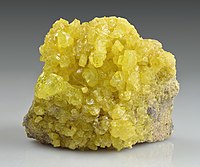
Photo from wikipedia
Background The prevalence of allergic diseases is gradually increasing worldwide. The most common such allergic disease is allergic rhinitis (AR). Objective The present study investigated the possible relationship between seasonal… Click to show full abstract
Background The prevalence of allergic diseases is gradually increasing worldwide. The most common such allergic disease is allergic rhinitis (AR). Objective The present study investigated the possible relationship between seasonal AR and the thiol-disulfide balance and zinc and copper levels in adult individuals. Study Design and Methods 130 male and female adults were included in the study. The participants' serum thiol-disulfide balance and zinc and copper levels were measured spectrophotometrically using commercial kits. Statistical significance was accepted as p < 0.05 between the groups. Results The serum copper (p = 0.001), native thiol (p = 0.006), reduced thiol (p < 0.001), and thiol oxidation reduction ratio (p < 0.001) levels were significantly lower in the seasonal AR group than in the control group. Conclusion In AR patients, the low level of copper, which is an important trace element, the deterioration of the thiol-disulfide balance, which represents a unique indicator of the oxidant-antioxidant balance, the increased disulfide level caused by oxidative stress, and the decreased native thiol level can all serve as important biochemical markers.
Journal Title: African Health Sciences
Year Published: 2022
Link to full text (if available)
Share on Social Media: Sign Up to like & get
recommendations!